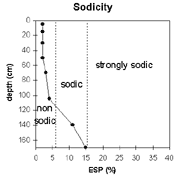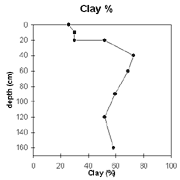NE44
| Property: Rutherglen Research Institute | Paddock #: 31 |
| Aust. Soil Class.: Haplic, Eutrophic, Red CHROMOSOL (slightly gravelly)/Vertic Yellow Sodosol | Northcote Factual Key: Dr 2.23 |
| Great Soil Group: no suitable group | Map Unit: Type G |
| General Landscape Description: Lower midslope (3% slope) of hill composed of Ordovician sediments. | |
Soil Profile Morphology:
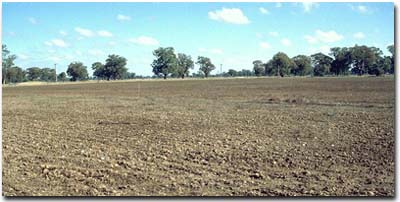
NE44 Landscape
Surface Soil
| A1 | 0-10 cm | Dark brown (7.5YR3/4); fine sandy clay loam; hardsetting; weak coarse blocky, breaking to weak medium blocky structure; firm consistence dry; pH 6.1; clear change to: | 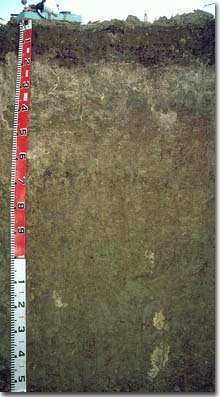 NE44 Profile |
| A2 | 10-20 cm | Yellowish red (5YR4/6); fine sandy clay loam; structureless; strong consistence dry; pH 5.2; abrupt change to: | |
| Subsoil | |||
| B21 | 20-40 cm | Dark red (2.5YR4/8); medium clay; moderate coarse polyhedral, breaking to moderate medium polyhedral structure; very firm consistence dry; contains a few (2%) ferruginous nodules (2-5 mm size) and a common (10%) amount of quartz gravel (2-5 mm size); pH 6.0; clear change to: | |
| B22 | 40-60 cm | Strong brown (7.5YR5/8) with red (2.5YR4/6) mottles; light medium clay; moderate coarse polyhedral, breaking to moderate medium polyhedral structure; very firm consistence dry; contains a few (2%) ferruginous nodules (2-5 mm size); pH 7.0; gradual change to: | |
| B23 | 60-90 cm | Yellowish brown (10YR5/8) with dark red (2.5YR4/6) mottles; medium clay; strong medium polyhedral, breaking to moderate fine polyhedral structure; very firm consistence dry; pH 7.5; clear and wavy change to:B24 | |
| B24 | 90-120 cm | Yellowish brown (10YR5/8) with dark red (2.5YR4/8) mottles; light medium clay; moderate medium polyhedral structure; strong consistence dry; contains manganese stains and very many (60%) quartz gravel fragments (2-20 mm size range); pH 7.8; clear wavy change to: | |
| B25 | 120-160 cm | Brownish yellow (10YR6/8) with dusky red (7.5R2.5/4) mottles; light medium clay; very firm consistence moist; contains many (20%) ferruginous nodules (6 mm size); gradual and wavy change to: | |
| 2B2b | 160+ cm | Light olive brown (2.5Y6/4) with yellowish red (5YR5/8) mottles; medium heavy clay; strong consistence dry; pH 8.5. | |
Key Profile Features:
- Strong texture contrast between surface (A) horizons (< 30% clay) and subsoil (B21) horizon (52% clay).
- The deep subsoil (from 160 cm depth) is part of an older Quaternary land surface. Note the characteristic lighter colour, strong prismatic structure (associated with strongly sodic conditions) and strong slickenside development (indicating different clay mineralogy).
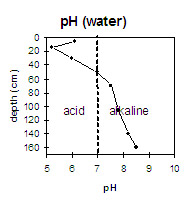 |
| 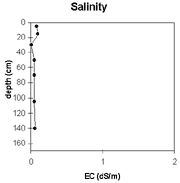 |
|
|
|
|
|
Management Considerations:
Whole Profile
- Plant available water capacity (PAWC) is considered to be medium (estimated at 115 mm) for the top metre of the soil profile. This is based on available laboratory data.
- The surface soil has a very high fine sand and silt content (ie. 76 %). Organic matter is therefore important for maintaining aggregation and preventing slaking. Practices which increase soil organic matter (eg. minimum tillage, stubble retention, pasture rotations, direct drilling) should be adopted.
- The surface (A1) horizon is only slightly acid (compared to a strongly acid A2 horizon) which reflects recent lime applications. The strongly acid subsurface (A2) horizon indicates that aluminium and manganese toxicity may occur. The level of exchangeable aluminium measured in the laboratory (33 ug/g) is not high, however, and unlikely to restrict plant growth. This is best assessed, however, from samples taken across the paddock.
- The upper subsoil is reasonably structured (breaking to medium sized polyhedral shaped peds), non-sodic and non-dispersive. Root and water movement is not likely to be significantly restricted as a result.
- The nutrient status of the subsoil (based on the sum of the exchangeable basic cations) is low-moderate.
- Cultivated (1977), disc cultivated (1984)
- Lime applied (1 cwt/acre, 1983) (1 t/ha, 1994)
- Lupins grown
- Clover sown in 1995

